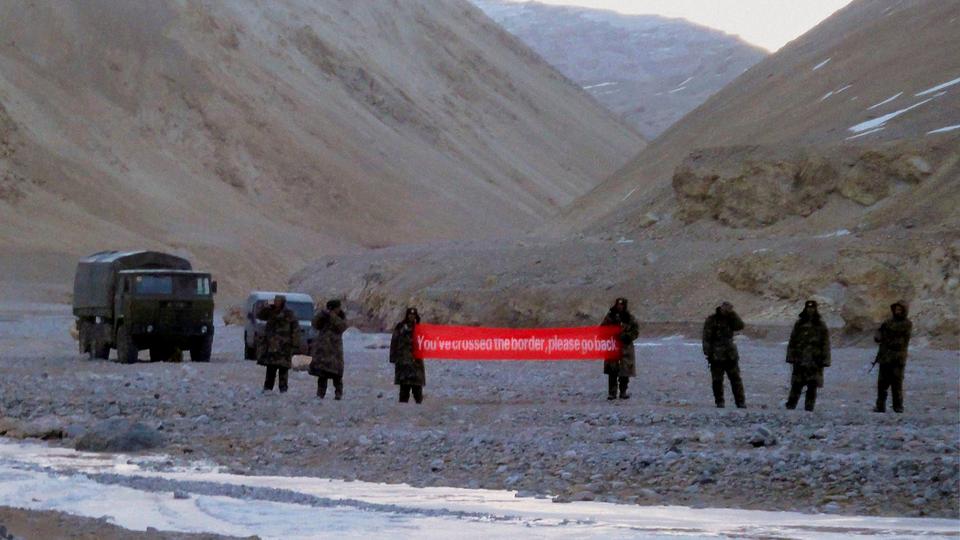India's
top military brass meets PM Modi amid escalating border tension with China

NEW
DELHI: In the midst of escalating border tension between Indian and Chinese
troops in eastern Ladakh, Prime Minister Narendra Modi on Tuesday held a meeting with
National Security Adviser Ajit Doval, Chief of Defense Staff General Bipin
Rawat and the three service chiefs with a focus on bolstering India's military
preparedness to deal with external security challenges, government sources
said.
The military brass is learnt to have apprised PM Modi about the evolving
situation in eastern Ladakh, though officials maintained that the agenda of the
pre-scheduled meeting was to discuss the ambitious military reforms and ways to
boost India's combat prowess.
The
meeting came hours after the top four generals briefed Defense Minister Rajnath
Singh about the situation in Pangong Tso lake, Galwan Valley, Demchok and
Daulat Beg Oldi where the Indian and Chinese troops were engaged in aggressive
posturing for the last 20 days.
People in the military establishment said the Prime Minister was briefed about
the situation in Ladakh. There was no official comment or details available
about the meeting.
NEWS IN BRIEF
Official
sources said NSA Doval has been closely monitoring the evolving situation along
the LAC in Ladakh as well as in north Sikkim and Uttarakhand.
"China's strategy to put military pressure on India will not work. We want
restoration of the status quo along the LAC," said an official on the
condition of anonymity.
In the meeting, the top military brass is learnt to have apprised Modi about
the implementation of key infrastructure projects along the LAC, the de-facto
border with China.
Official sources said India will not stop infrastructure development projects
in strategic areas along the nearly 3,500-km Sino-India border, notwithstanding
China's well-coordinated efforts to stall them by attempting to vitiate the
situation in areas like eastern Ladakh.
It is learnt that the defense minister has already conveyed to top military
brass that there was no need for reviewing the implementation of any of the key
projects along the LAC in Ladakh, Sikkim, Uttarakhand or in Arunachal Pradesh.
In view of the nearly 20-day standoff between the two sides, the Indian Army
has significantly ramped up its presence in sensitive border areas in North
Sikkim, Uttarakhand and Arunachal Pradesh besides Ladakh to send across a
message that India will not be wilting under any aggressive military posturing
by China, the sources said.
The Chinese side has been particularly peeved at India laying a key road in the
finger area of Pangong Tso Lake region besides another road connecting the
Darbuk-Shayok-Daulat Beg Oldie road in Galwan Valley.
The situation in eastern Ladakh deteriorated after around 250 Chinese and
Indian soldiers were engaged in a violent face-off on the evening of May 5
which spilled over to the next day before the two sides agreed to
"disengage" following a meeting at the level of local commanders.
Over 100 Indian and Chinese soldiers were injured in the violence. The trigger
for the incident was China's strong objection to the road being laid by India
in the Finger area in Pangong Tso lake.
The incident in Pangong Tso was followed by a similar incident in North Sikkim
on May 9.
Since then, Chinese military has increased its strength in Pangong Tso lake,
Galwan Valley, Demchok and Daulat Beg Oldi, and resorting to "aggressive
patrolling" in these areas. The Indian Army is also carrying out similar
exercise in the region, sources said.
India last week said the Chinese military was hindering normal patrolling by
its troops and asserted that India has always taken a very responsible approach
towards border management.
At a media briefing, External Affairs Ministry Spokesperson Anurag Srivastava
also strongly refuted China's contention that the tension was triggered due to
trespassing by Indian forces on the Chinese side.
India's response came two days after China accused the Indian Army of
trespassing into its territory, claiming that it was an "attempt to
unilaterally change the status" of the LAC in Sikkim and Ladakh.
On May 5, the Indian and Chinese army personnel clashed with iron rods, sticks,
and even resorted to stone-pelting in the Pangong Tso lake area in which
soldiers on both sides sustained injuries.
In a separate incident, nearly 150 Indian and Chinese military personnel were
engaged in a face-off near Naku La Pass in the Sikkim sector on May 9. At least
10 soldiers from both sides sustained injuries.
The troops of India and China were engaged in a 73-day stand-off in Doklam tri-junction in 2017 which even
triggered fears of a war between the two nuclear-armed neighbors.
In
the meeting with the Prime Minister, sources said, Gen Rawat apprised him about
the implementation of the recommendations by the Lt Gen (retd) Shekatkar
committee for military modernization.
The government has accepted almost all recommendations of the panel including
ways to bolster border infrastructure.
India's top military brass meets PM Modi amid escalating border tension with China
![India's top military brass meets PM Modi amid escalating border tension with China]() Reviewed by Muhammad Umar
on
May 27, 2020
Rating:
Reviewed by Muhammad Umar
on
May 27, 2020
Rating:







No comments:
Post a Comment